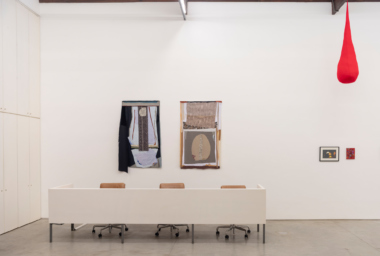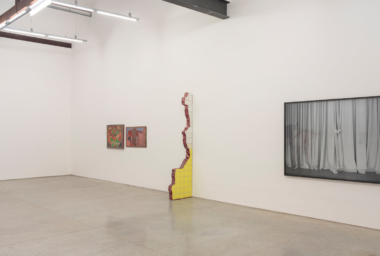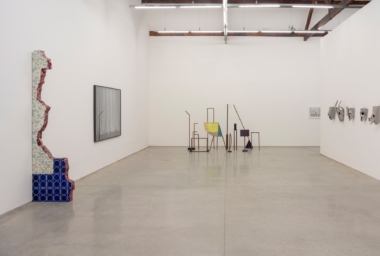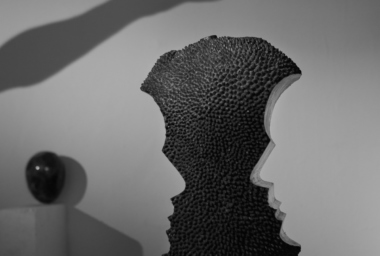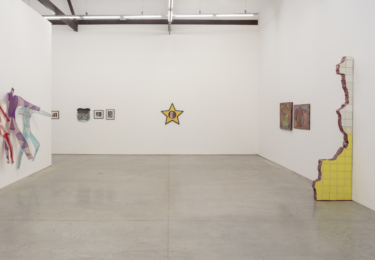
Perdona que no te crea
Feb 2 – Mar 9, 2019
Curated by Victor Gorgulho
Opening
Feb 2, 4 pm–7 pm
Carpintaria
Rua Jardim Botânico 971,
Rio de Janeiro
Directions
Download
Daniel Albuquerque | Tiago Cadete | Tiago Carneiro da Cunha | Leda Catunda | Flávio de Carvalho | Cia. dos Atores | Teatro Experimental do Negro | Surubim Feliciano da Paixão | Cristiano Lenhardt | João Maria Gusmão | João Maria Gusmão & Pedro Paiva | Ana Mazzei | Teatro Oficina Uzyna Uzona | Rodolpho Parigi | Sara Ramo | Nuno Ramos | Mauro Restiffe | Marina Rheingantz | Luiz Roque | Valeska Soares | Vania Toledo | Adriana Varejão | Erika Verzutti | Francesco Vezzoli | Yuli Yamagata
Perdona que no te crea investigates the crossing between the fields of visual arts and theater in its intersections and particularities, reinforcing Carpintaria’s vocation to propose dialogues between artists, languages and disciplines. The exhibition’s title is inspired by the bolero Puro Teatro, composed by Puerto Rican Tite Curet Alonso in 1970.
Just like in a scene, you perform your cheap pain, state the first verses of the song, famously sang by Cuban singer La Lupe. Right at the entrance, the exhibition space merges with a scenic atmosphere as contemporary pieces share the gallery with historical photographic records. The collages made with fabric, thread and paper by Sara Ramo work as curtains that open and reveal Marionete (2018) by Marina Rheingantz and Cruzeiro (2018) by Leda Catunda, pieces that employ almost theatrical materialities, displayed next to photographs of plays such as Melodrama (1995) by Cia. dos Atores and Otelo, by Shakespeare, played by Abdias do Nascimento’s Teatro Experimental do Negro, in 1946. In a dialogue, they develop relationships between apparatus and role-playing, materials and drama, performance and farce.
To think of a theatrical dimension in art dates back to baroque, back in the 16th century, when painting and sculpture are taken by expressivity and exaggeration through the use of lighting and the realistic reproduction of gestures and performances. If “the baroque space is the one of overabundance”, in the words of poet and critic Severo Sarduy, Adriana Varejão’s Ruína Modernista (2018) draws inspiration from this heritage when making a performance of flesh, building up a matter which does not intend to be credible, but theatrical. Next to the piece, the paintings of naïf nature by Surubim Feliciano da Paixão design a role-playing dynamic in such a way the self-taught painter – janitor and scenery technician at Teatro Oficina, in São Paulo, in the 80s – documents his experiences at the rehearsals of Misterios Gozosos played in 1984 by the company.
On the opposite wall, are presented artistic practices that are circumscribed to a frontier area between theater and art. Jussaras (2019) by Cristiano Lenhardt are garments that turn the geometrical thought developed by the artist in his engravings about a decade ago three dimensional, working as a sculptural and also as a performing presence, being activated – worn – around the exhibition space. On the same wall, there are aluminum masks by Flávio de Carvalho, originally made for O Bailado do Deus Morto, text by the same author staged in 1933 by his group Teatro de Experiência. Carvalho, whose actions happened in different fields of art, has transited between the two fields throughout his journey, making experiments that blur the frontiers between theatricality and performativity, such in his famous new looks – blouses and skirts worn in happenings in the 1950s. In the back of the room, Ghosts (2017) by Ana Mazzei, gathers a sculptural set of theatrical presence in which each piece – or actor – confronts the viewer frontally and duels for the perspective. Who is watching whom after all?
In Carpintaria’s front room, the physicality of forms of painting Blue Violet Eckout (2019), by Rodolpho Parigi, duels two-dimensionality since they seem to want to surpass the plane, to burst it. This is what seems to be at stake also in the ingenious composition Chat and Drinks (2018), by Yuli Yamagata, in which the artist seams fabrics such as lycra and silicon fiber without abandoning pictorial thought as a starting point. This kind of material bluff also shows in the little clay sculptures by Daniel Albuquerque, which take the mimetic urge of the form to the extreme when reproducing parts of a fragmented absent body in human scale.
The shaky voice that hovers over the exhibition space comes from Carta (2019), piece in which Portuguese artist Tiago Cadete reads the full report made by Pero Vaz de Caminha in the occasion of his arrival in Brazilian lands. Veiled in one of Carpintaria’s cabinets, the voice distorts and satirizes the text by the Portuguese explorer, which reports with the Eurocentric arrogance of the times the first encounter between the Portuguese and the natives. The eloquence of Caminha’s words, in Cadete’s voice, allows for dubious readings about the conflicting meeting. Perdona que no te crea… me parece que es teatro?
